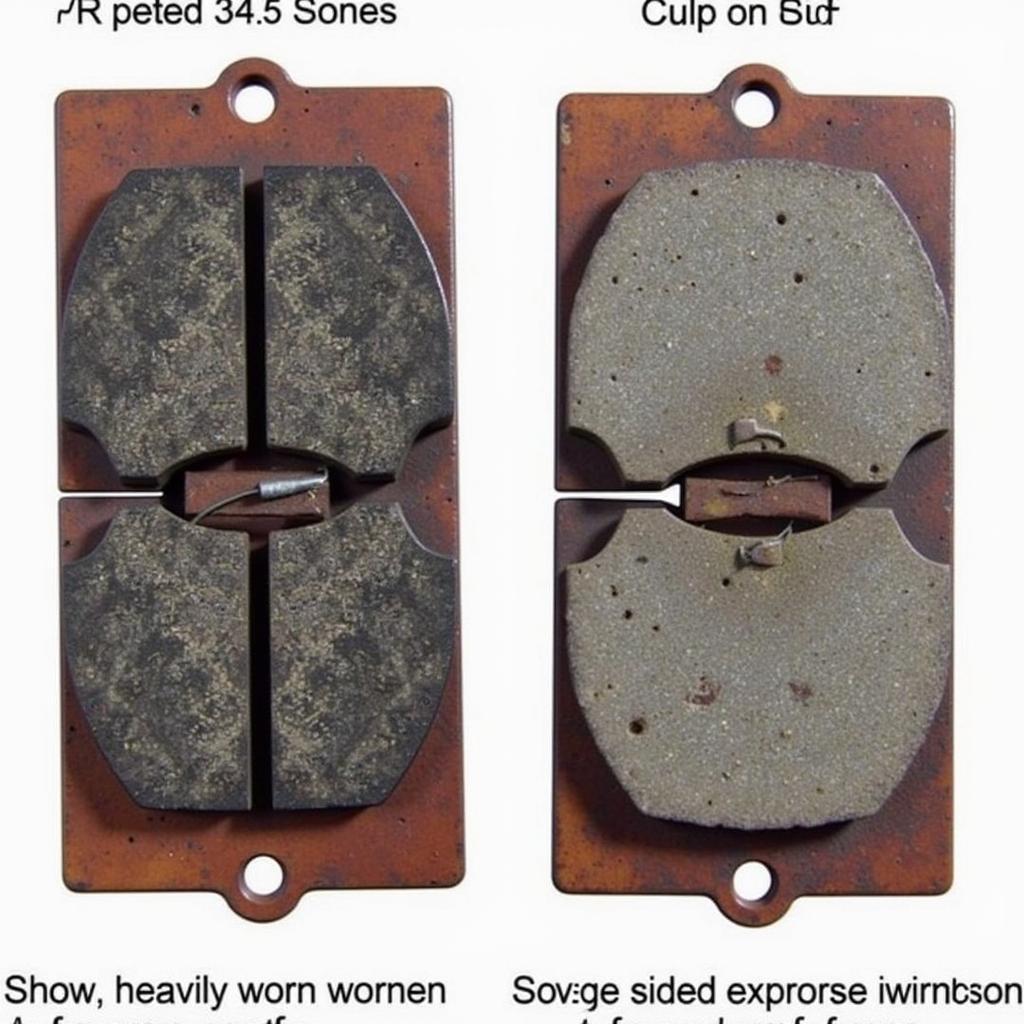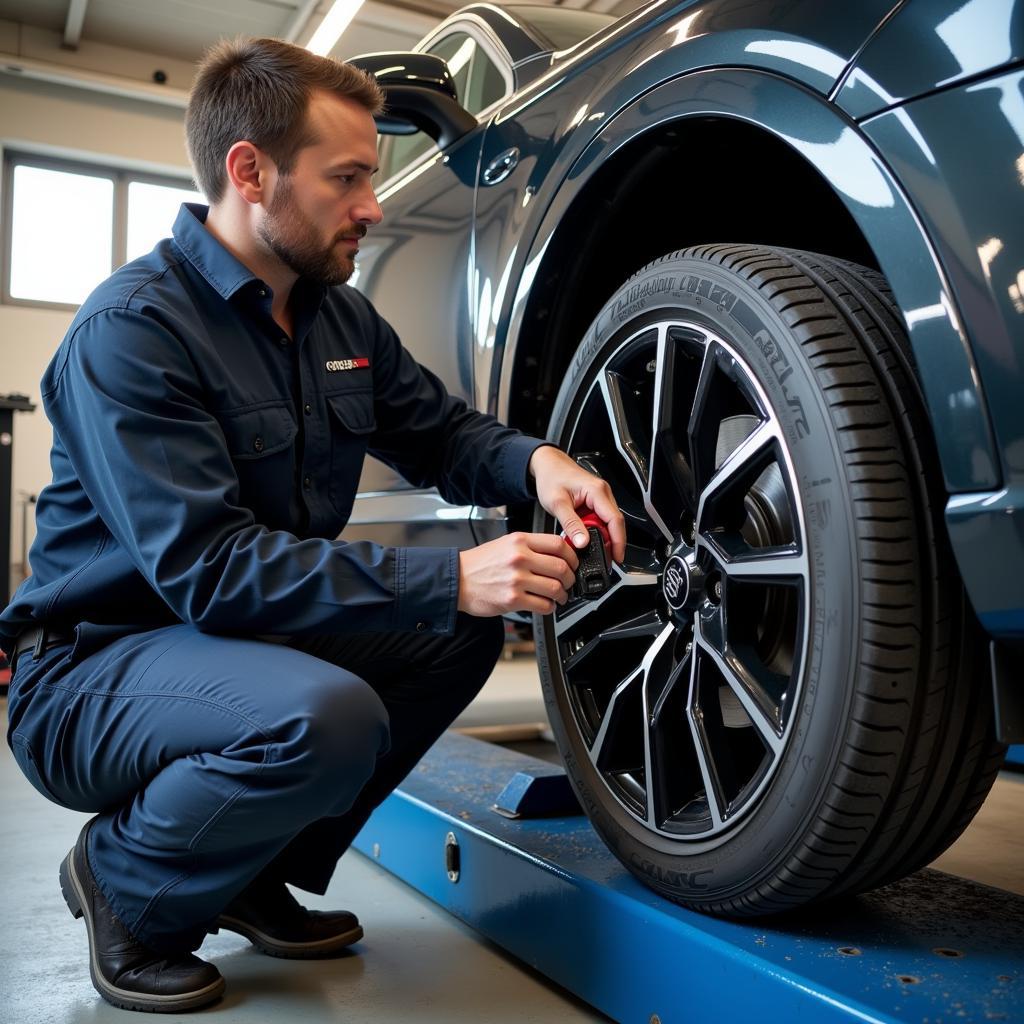Picture this: you’re cruising down the highway, enjoying the smooth ride in your Audi Q7, when suddenly a yellow warning light depicting a circle with brake pads on each side illuminates your dashboard. This is the dreaded “brake pad warning light”, a clear sign that your Audi Q7 is trying to tell you something important about its braking system. Ignoring this warning could not only be costly in terms of repairs but could also jeopardize your safety and that of your passengers.
Understanding Your Audi Q7’s Brake Pad Warning Light
The brake pad warning light on your Audi Q7 is a crucial part of its sophisticated safety system. Unlike some warning lights that might indicate minor issues, this one demands immediate attention. It typically means your brake pads have worn down to a point where they need to be replaced soon.
Modern Audi Q7s are equipped with a sensor embedded within the brake pads themselves. This sensor, usually a small wire loop, acts as a trigger. When the brake pad material wears down to a critical level, the sensor makes contact with the brake rotor, completing a circuit and illuminating the warning light on your dashboard.
Common Causes of the Brake Pad Warning Light
While worn brake pads are the most common culprit, other factors can trigger the warning light in your Audi Q7:
- Worn Brake Pad Sensor: The sensor itself could be faulty or damaged. This can happen due to wear and tear, corrosion, or even improper installation.
- Low Brake Fluid Level: Brake fluid is essential for transmitting the force you apply on the brake pedal to the brake calipers, ultimately stopping your vehicle. If the brake fluid level is low, it could trigger the brake pad warning light as well.
- Issues with the Braking System: Problems within the braking system, such as a malfunctioning ABS (Anti-lock Braking System) module, can also illuminate the warning light.
What to Do When the Brake Pad Warning Light Comes On
- Don’t Panic, But Don’t Ignore It: Stay calm, but don’t make the mistake of dismissing the warning light. Continuing to drive with severely worn brake pads can damage your rotors, leading to more expensive repairs.
- Check Your Brake Pads: If you’re comfortable with basic car maintenance, you can visually inspect your brake pads. Look through the spaces between the wheel spokes for the brake caliper and pads. If the pad material is less than 1/4 inch thick, it’s time for a replacement.
- Check Your Brake Fluid Level: Locate the brake fluid reservoir under the hood of your Audi Q7. The reservoir will have a “Min” and “Max” marking. Ensure the fluid level is within this range.
- Seek Professional Help: If you’re unsure about any aspect of inspecting your brakes or if you suspect a more complex issue, it’s best to take your Audi Q7 to a qualified mechanic or dealership for a thorough inspection.
 Comparison of Worn Brake Pads and New Brake Pads
Comparison of Worn Brake Pads and New Brake Pads
The Importance of Timely Brake Pad Replacement
“Ignoring your brake pad warning light is like ignoring a ticking time bomb,” says Tim Miller, a seasoned Audi mechanic with over 20 years of experience. “Not only will you end up paying more for repairs down the line, but you’re also putting yourself and others at risk.”
Timely brake pad replacement ensures optimal braking performance, extends the life of your rotors, and most importantly, keeps you safe on the road.
Can I Reset the Brake Pad Warning Light Myself?
While some online resources might offer DIY solutions for resetting the brake pad warning light, it’s generally not recommended, especially if you’re not familiar with your Audi Q7’s specific system. Improper resetting can mask underlying problems and delay necessary repairs.
 Audi Q7 Undergoing Inspection at a Mechanic Shop
Audi Q7 Undergoing Inspection at a Mechanic Shop
Preventing Future Brake Pad Warning Lights
- Adopt Smooth Driving Habits: Avoid harsh braking whenever possible. Gradual braking reduces wear and tear on your brake pads.
- Be Mindful of Driving Conditions: City driving with frequent stop-and-go traffic tends to wear out brake pads faster than highway driving.
- Regular Maintenance is Key: Adhere to your Audi Q7’s recommended maintenance schedule. This includes regular brake inspections and fluid flushes, which can help identify potential issues before they become major problems.
Conclusion
The brake pad warning light in your Audi Q7 is a critical safety feature, not an annoyance to be ignored. Addressing the issue promptly ensures optimal braking performance, extends the lifespan of your braking components, and most importantly, keeps you and your passengers safe on the road. If you’re unsure about any aspect of your Audi Q7’s brake system, don’t hesitate to seek professional help.
Remember, when it comes to brakes, erring on the side of caution is always the safest approach.
FAQs About Audi Q7 Brake Pad Warning Lights
1. How long can I drive with the brake pad warning light on?
It’s strongly advised not to drive with the brake pad warning light on. Get your brake pads checked and replaced as soon as possible.
2. How much does it cost to replace brake pads on an Audi Q7?
Brake pad replacement costs can vary depending on factors like labor rates and the type of brake pads used.
3. Can I replace my Audi Q7 brake pads myself?
While it’s possible, replacing brake pads requires mechanical expertise. If you’re not comfortable, it’s recommended to have a professional handle it.
4. How often should I get my Audi Q7’s brakes checked?
It’s a good practice to have your brakes inspected at least once a year or every 10,000-12,000 miles.
5. What is the difference between the brake pad warning light and the parking brake light?
The brake pad warning light indicates worn brake pads. The parking brake light comes on when the parking brake is engaged.

